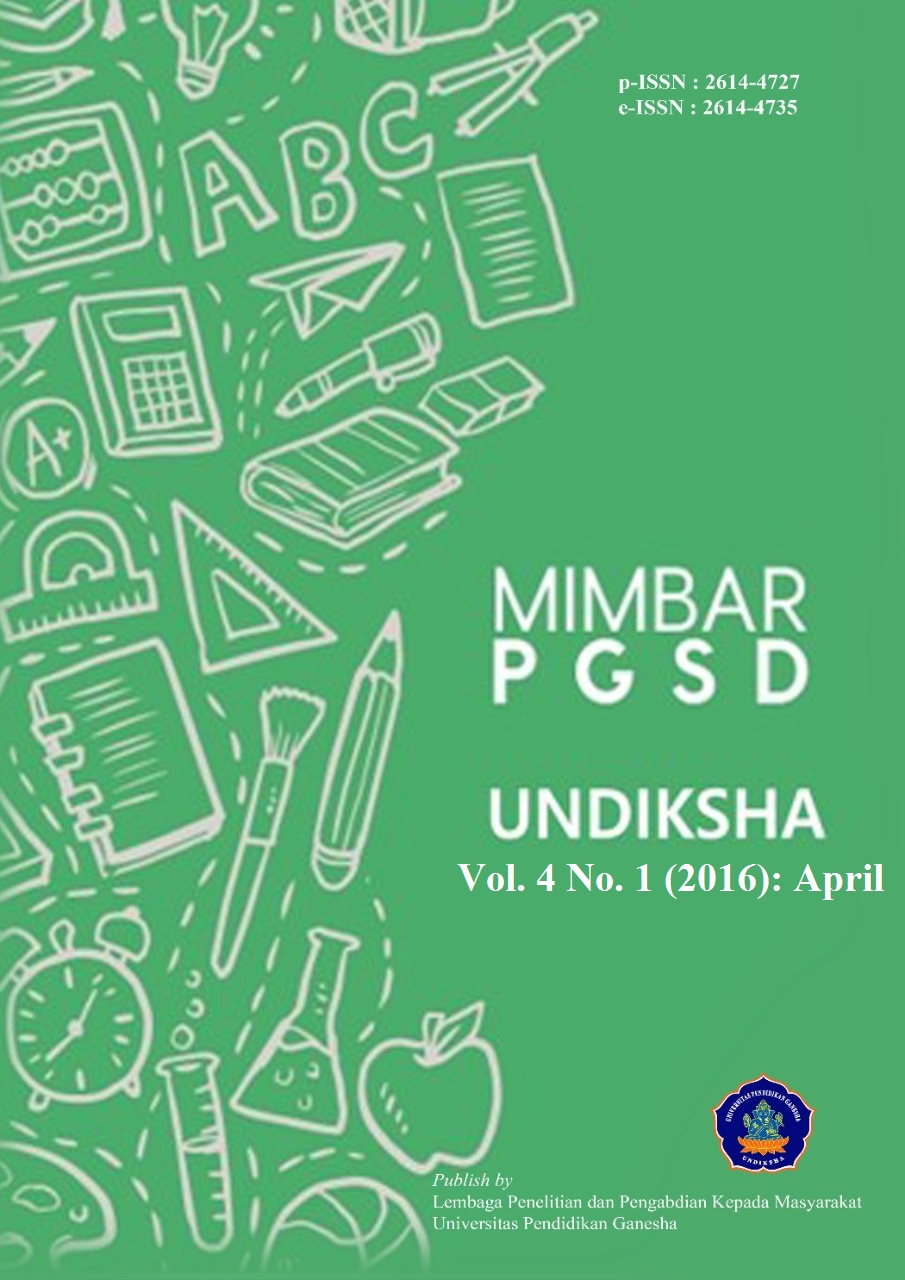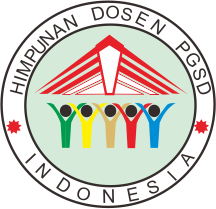MEDIA LINGKUNGAN PENGARUH MODEL PEMBELAJARAN SRL BERBANTUAN MEDIA LINGKUNGAN TERHADAP MOTIVASI BELAJAR IPA SISWA SD
DOI:
https://doi.org/10.23887/jjpgsd.v4i1.6956Abstract
Abstrak Permasalahan yang diangkat dalam penelitian ini adalah rendahnya motivasi belajar IPA pada siswa kelas V di Gugus IV Kecamatan Selat Kabupaten Karangasem. Penelitian ini bertujuan untuk mengetahui perbedaan motivasi belajar IPA antara siswa yang mengikuti pembelajaran Self Regulated Learning (SRL) berbantuan media lingkungan dan konvensional pada siswa kelas V di Gugus IV Kecamatan Selat Kabupaten Karangasem. Jenis penelitian ini adalah penelitian eksperimen semu. Sampel penelitian ini yaitu siswa kelas V SDN 4 Muncan yang berjumlah 26 orang dan siswa kelas V SDN 2 Muncan yang berjumlah 22 orang. Pengumpulan data pada penelitian ini menggunakan metode pengumpulan data non-test yaitu kuisioner motivasi. Data yang dikumpulkan dianalisis menggunakan analisis statistik deskriptif dan statistik inferensial (uji-t). Hasil penelitian ini menemukan bahwa terdapat perbedaan motivasi belajar IPA yang signifikan antara kelompok siswa yang mengikuti pembelajaran Self Regulated Learning (SRL) berbantuan media lingkungan dan siswa yang mengikuti pembelajaran model pembelajaran konvensional (ttabel = 1,675 > thitung = 35,6). Perbandingan hasil perhitungan rata-rata motivasi belajar IPA siswa yang mengikuti pembelajaran dengan model pembelajaran Self Regulated Learning (SRL) berbantuan media lingkungan adalah 132,96 lebih besar dari rata-rata motivasi belajar IPA siswa yang mengikuti pembelajaran model konvensional adalah 96,4. Hal ini berarti penerapan model pembelajaran Self Regulated Learning (SRL) berbantuan media lingkungan berpengaruh terhadap motivasi belajar IPA siswa kelas V semester genap di Gugus IV Kecamatan Selat Kabupaten Karangasem tahun pelajaran 2015/2016.Kata Kunci : SRL, media lingkungan, motivasi belajar
Abstract Issues raised in this study is the lack of motivation to learn science in grade V in Cluster IV District of Karangasem regency Strait. This study aims to determine the differences between students' motivation to learn science the following study Self-Regulated Learning (SRL) assisted and conventional media environment at fifth grade students in Cluster IV District of Karangasem regency Strait. This research is a quasi-experimental research. Samples of this study are students of class V SDN 4 Muncan totaling 26 people, and fifth grade students of SDN 2 Muncan amounting to 22 people. Collecting data in this study using a non-test data collection is questionnaire motivation. Data collected were analyzed using descriptive statistical analysis and inferential statistics (t-test). Our research found that there are differences in motivation to learn science significantly between groups of students who take the learning Self Regulated Learning (SRL) aided environmental media and students following the conventional learning model study (table = 1,675> t = 35.6). Comparison of the results of the calculation of average motivation to learn science students who take the learning to the learning model Self Regulated Learning (SRL) aided 132.96 media environment is greater than the average motivation to learn science students who take the conventional model study was 96.4. This means learning model application Self-Regulated Learning (SRL) aided the media environment affect motivation for fifth grade science students in the second semester of Cluster IV District of Karangasem regency Strait academic year 2015/2016.
keyword : SRL, learning motivation
Published
2016-06-11
How to Cite
., D. J., ., P. D. G. S., & ., I. G. M. S. M. (2016). MEDIA LINGKUNGAN PENGARUH MODEL PEMBELAJARAN SRL BERBANTUAN MEDIA LINGKUNGAN TERHADAP MOTIVASI BELAJAR IPA SISWA SD . MIMBAR PGSD Undiksha, 4(1). https://doi.org/10.23887/jjpgsd.v4i1.6956
Issue
Section
Articles
License
Authors who publish with the Mimbar PGSD Undiksha agree to the following terms:
- Authors retain copyright and grant the journal the right of first publication with the work simultaneously licensed under a Attribution-ShareAlike 4.0 International (CC BY-SA 4.0) that allows others to share the work with an acknowledgment of the work's authorship and initial publication in this journal.
- Authors are able to enter into separate, additional contractual arrangements for the non-exclusive distribution of the journal's published version of the work (e.g., post it to an institutional repository or publish it in a book), with an acknowledgment of its initial publication in this journal.
- Authors are permitted and encouraged to post their work online (e.g., in institutional repositories or on their website) prior to and during the submission process, as it can lead to productive exchanges, as well as earlier and greater citation of published work. (See The Effect of Open Access)












